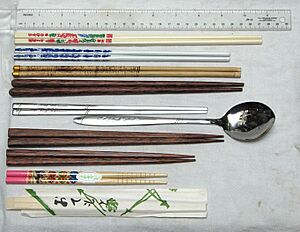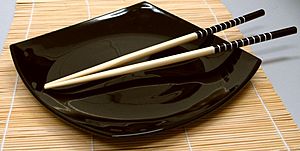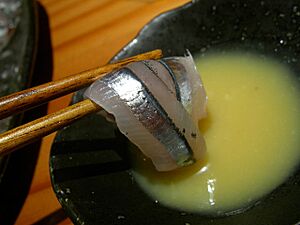Chopsticks facts for kids
Chopsticks are two small sticks used as a pair to pick up food. They are the traditional eating tools in many countries, like China, Japan, Korea, Malaysia, and Vietnam.
Chopsticks can be made from different materials such as wood, bamboo, plastic, gold, silver, or ivory. Gold and silver chopsticks are much heavier and are seen as very fancy.
Today, chopsticks are mostly used in China and nearby countries. You will also often find them in restaurants around the world that serve Asian food.
Contents
History of Chopsticks
Chopsticks first appeared in China during the Shang Dynasty (around 1600–1100 BC). Some people think the ideas of Confucius might have influenced their creation. They became popular all over East Asia.
Tools similar to chopsticks were even found in an old digging site called Tel Megiddo in Israel. This might mean that people traded goods between the Middle East and Asia a very long time ago. Or, it could mean that people in both places came up with similar tools on their own. Chopsticks were also common items for the Uyghur people in Mongolia between the 6th and 8th centuries.
Where the Word "Chopstick" Comes From
The English word "chopstick" probably comes from an old way of speaking called Chinese Pidgin English. In this language, "chop chop" meant "quickly."
In Mandarin Chinese, chopsticks are called kuàizi (筷子). This word is made of two parts: "快" which means quick, and "竹" which means bamboo.
The older Chinese word for chopsticks was zhù (箸). But on ships, zhù sounded like another word meaning "to stop." Because of this, people started using a new word, kuài, which means "fast" or "quick." This new word slowly became the common word for chopsticks in most parts of China. The Chinese character for this new meaning (筷) has the bamboo part added to the character for "fast" (快).
In Japanese, chopsticks are called hashi (箸). You might also see them called otemoto (おてもと), which is often printed on disposable chopsticks.
In Korean, the word for chopsticks is jeotgarak (젓가락). It combines jeo (chopsticks) and garak (stick). You usually don't use jeo by itself.
In Vietnamese, chopsticks are called "đũa."
How to Eat with Chopsticks
When you eat with chopsticks, you usually don't use a knife and fork. Both sticks are held in the same hand, usually the right hand. In some formal situations, it might be considered impolite to use chopsticks with your left hand.
Here's how to hold them:
- Place one chopstick between your palm and the base of your thumb. Use your ring finger (the one next to your pinky) to support the bottom of this stick. Your thumb should press it down, and your ring finger should push it up. This stick should stay still and be very stable.
- Hold the other chopstick like you would hold a pen, using the tips of your thumb, index, and middle fingers. Make sure the tips of both chopsticks line up.
- Move only the top chopstick up and down towards the still bottom chopstick.
- With practice, the two sticks will work like a pair of small tongs, making it easy to pick up food.
If the tips of your chopsticks don't line up, it will be hard to pick up food. You can gently tap the tips on the table or slightly loosen your grip to make them even. You can also adjust how you hold them until it feels comfortable.
Table Manners with Chopsticks
Chopstick Etiquette
When eating with chopsticks, people usually follow these rules:
- Do not use chopsticks to make noise, get attention, or make gestures. Playing with your chopsticks is seen as rude.
- Do not use chopsticks to move bowls or plates.
- Do not play with your food or with the shared dishes using your chopsticks.
- Most of the time, you should not stab food with chopsticks. However, it's okay to tear larger items like vegetables or kimchi apart. Sometimes, people might stab small, hard-to-pick-up items like cherry tomatoes, but traditionalists don't like this.
- You can rest your chopsticks horizontally on your plate or bowl to keep them off the table. A special chopstick rest can also be used.
- Never leave chopsticks standing straight up in a bowl of rice or other food. This looks like the incense sticks used in some ceremonies to honor family members who have passed away.
- Do not eat if the tips of your chopsticks are not lined up properly. In Chinese culture, this is sometimes linked to bad luck.
Different Kinds of Chopsticks

Chopsticks are used in many countries, and they can look different depending on where you are.
- Chinese chopsticks: These are longer sticks that are square at the end where you hold them and round at the end that touches the food. They have a blunt (not sharp) tip.
- Japanese chopsticks: These are short to medium length and have a pointed end. This might be because the Japanese diet includes a lot of whole fish. Japanese chopsticks are usually made of wood and are often covered in a special shiny coating called lacquer. Some sets have two lengths: shorter ones for women and longer ones for men. You can also find child-sized chopsticks.
- Korean chopsticks: These are medium-length, made of stainless-steel, and are flat and rectangular. (In the past, they were made of brass or silver.) Many Korean metal chopsticks have decorations where you hold them.
- Vietnamese chopsticks: These are long sticks with a blunt tip. They were traditionally made of wood, but now they are also made of plastic. A đũa cả is a large, flat pair of chopsticks used to serve rice from a pot.
Other Ways Chopsticks Are Used
Chopsticks are also used in cooking to stir food in a pan or to move food around.
In Japan, people use a type of disposable chopstick called waribashi (split chopstick). Before using them, you split them into two. Japanese people also call their chopsticks hashi.
In Japan, chopsticks are used during some funeral ceremonies for Buddhists. After a person's body is burned, family and friends use chopsticks to move the burned bones from the coffin to a pot.
Things to Think About with Chopsticks
Chopsticks and the Environment
Using chopsticks only once and then throwing them away can cause problems for the environment. Many people are trying to encourage others to use chopsticks more than once. In China, about 45 billion pairs of disposable chopsticks are used each year. This uses up a lot of timber, which is like cutting down about 25 million fully grown trees.
China makes most of the world's disposable chopsticks, and about 60,000 people work in this industry. If they keep making them at the same rate, China's forests could disappear in about ten years.
Because of this, a tax has been added to chopsticks that are only used once. There are also efforts to use plastic or metal chopsticks instead of wooden disposable ones.
Chopsticks and Health
A study in 2003 found that people who use chopsticks often might have a slightly higher chance of getting arthritis in their hand. This is when the soft material (cartilage) in your joints wears away, causing pain. This is more common in older people. Another small concern is that using certain kinds of chopsticks might lead to coughing or even asthma.
The Hong Kong Department of Health did a study in 2006. It found that people generally used chopsticks or other serving tools more often when eating with others compared to 2003. It also showed that personal hygiene had improved.
Images for kids
-
Silver chopsticks, spoon, and bowl from the Song dynasty
-
A painting of a Japanese woman using chopsticks, by Utagawa Kuniyoshi
See also
 In Spanish: Palillos para niños
In Spanish: Palillos para niños



















